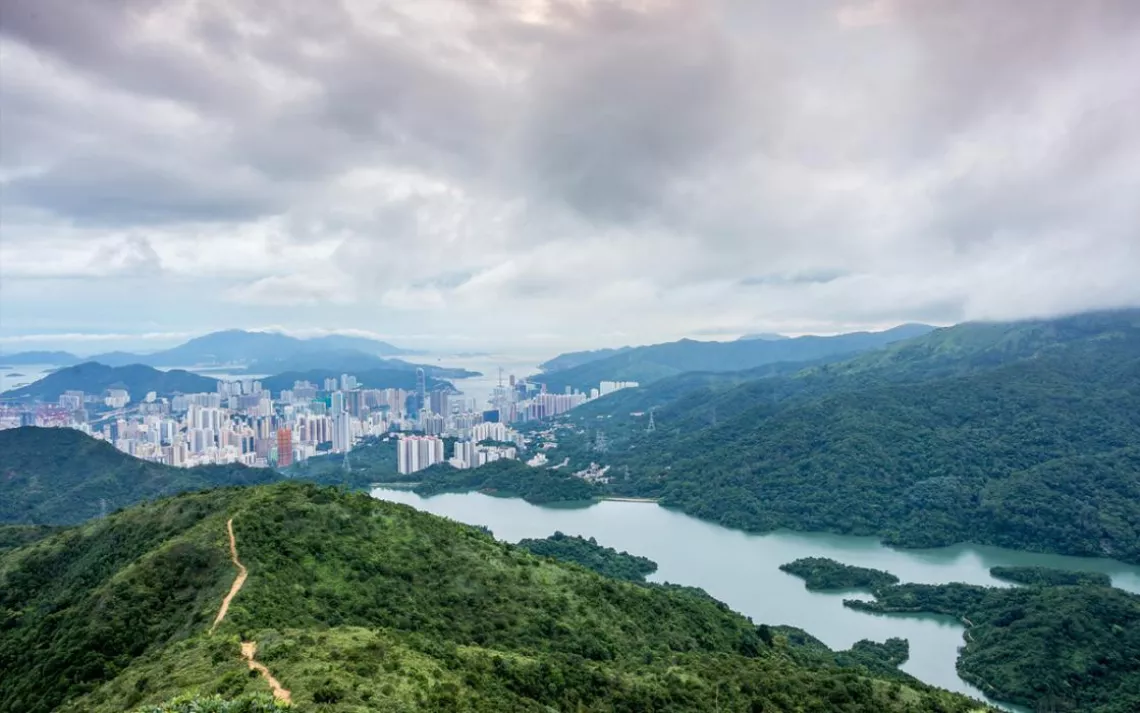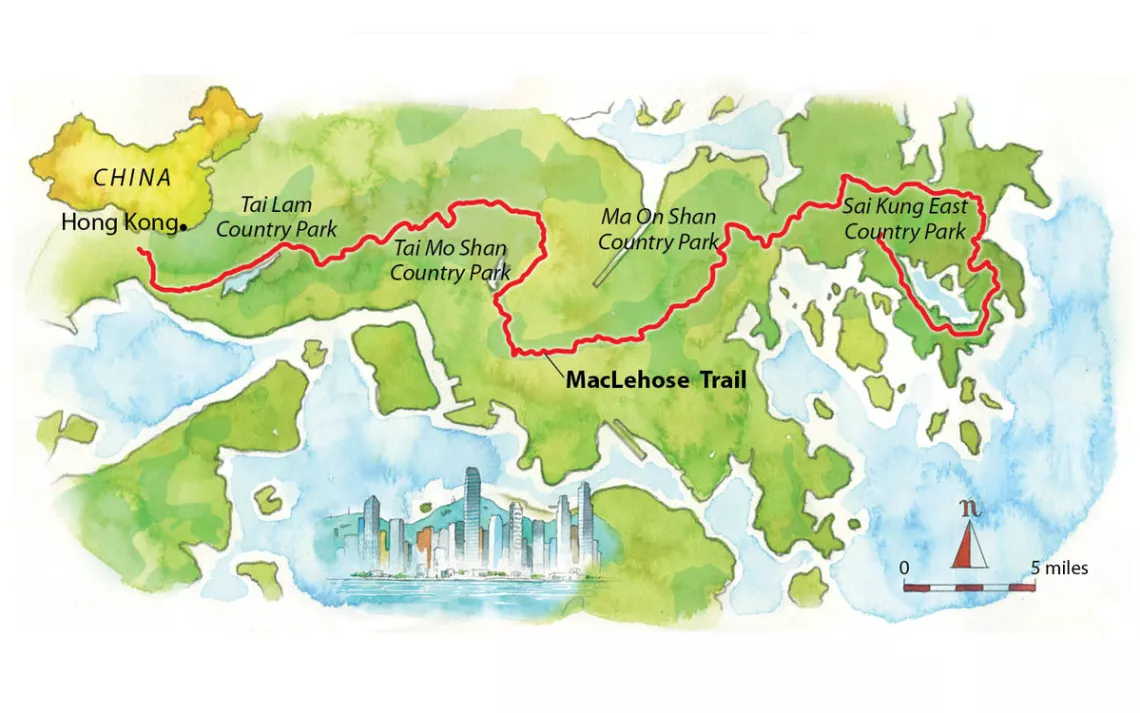The MacLehose Trail Is Hong Kong's Great Escape
The 62-mile trail is the wilder side of the Chinese territory

High-rises, power lines, and cell towers punctuate the view along the MacLehose Trail. | Photo by Tse Hon Ning
GAUZY LIGHTS FLICKER IN THE FOG, outlining a summit. Otherwise, darkness. The only sounds I can hear are my breathing and the rustling of my windbreaker. A rocky chasm yawns below me, just steps from the trail. For a moment, I imagine that I'm watching a search party traverse a remote wilderness.
But no, I'm solo hiking in Hong Kong, and the lights are the head-lamp beams of three other travelers on the MacLehose Trail. Beyond them, through occasional breaks in the fog, I can just barely see some of the blinking lights on the apartment towers—the edge of a global financial center where 7.4 million humans squeeze into an urban area roughly the size of Boston. Soon I'll be pitching a bright-orange tent on a seaside bluff, as far from that madding crowd as possible.
Hong Kong, a former British colony and now a semiautonomous Chinese territory, has some of the world's densest urban districts. But less than a quarter of its total land is inhabited. Another 40 percent—a noncontiguous area twice the size of Seattle—is divided into 24 country parks that receive more than 11 million visitors a year. The parks' peaks and ridges are known for their panoramic views of skyscrapers, but that's only part of their appeal: They also ease the stress of living in a crowded city wracked by soaring inequality.
It's hard to survive here without a generous corporate salary. Every month, my wife and I, both of us journalists, stretch our budget to rent a tiny walk-up apartment. The price of food and basic services always makes us cringe, and we never manage to save money. Our standard of living could be far worse: One in five Hong Kongers lives below the poverty line, and the affordable-housing crisis is so severe that some locals live in stacked cubicles called "cage homes" or "coffin cubicles." Hong Kong's extreme wealth disparities get under our skin. In our neighborhood, Ferraris and Lamborghinis whiz by a welfare office as the poor queue around the block.
Which explains why I often feel like escaping the grid for a few hours, to a place where trees outnumber people, the cellular signal can be hit or miss, and the Darwinian struggle is mainly waged by other species.

Map by Steve Stankiewicz
The future of the country parks is uncertain, however. The British established many of them in the 1970s, often on lands that bordered streams or reservoirs. Now, as Hong Kong's property market soars, a few local politicians are beginning to talk of carving up some of the parks to make room for housing. The initial cuts, if they ever occur, would likely be modest. But the mere suggestion has rattled conservation groups. Cutting into the parks would set a dangerous urban-development precedent, they warn, and the authorities should focus instead on developing idle sites near existing skyscrapers.
A key feature of the country parks is a nearly 200-mile network of four hiking trails. The longest is the MacLehose Trail, which runs for 62 miles and is named for the British official who governed Hong Kong in the 1970s. I like it because it takes me furthest afield.
The trail begins by edging along the South China Sea, darting through scrubby forests and along sandy bluffs. The air here is heavy with humidity and sea salt, and the location—the far corner of a vast country park—is free of condominiums. One summer afternoon, the only human presence I see from a bluff is an oil tanker cutting through whitecaps. Otherwise it's just me, the breeze, and a sea the color of my wife's engagement ring.
Farther on, the MacLehose passes through a village with surfboard rentals and open-air restaurants that smell of seafood and garlic. Nearby lies a white-sand beach that's tucked into a rocky cove and partially sheltered from the wind. Some local surfers say that the best break in the territory is here, though only in the winter typhoon season, when the swell picks up and the crowds of fair-weather weekenders thin out.
After its seaside leg, the MacLehose hooks west, brushing past the 2,303-foot summit of Ma On Shan (Horse Saddle Mountain) and across a miles-long ridge dotted with graffiti-spattered concrete pillboxes. British soldiers built this so-called Gin Drinkers Line of fortifications in the 1930s to protect nearby Hong Kong Island from invasion. Japanese forces seized the territory anyway, in 1941. Britain regained control after World War II, and the pillboxes still bear London-inspired names like Charing Cross and Shaftesbury Avenue.
"Artillery observation post," a sign on one of them says. "No playing war game."
The artillery is long gone. Today, high-rises, power lines, and cellular towers hover in the not-too-distant background along nearly the entire sweep of the trail. An "unspoiled" wilderness this is not; I'm never more than about 90 minutes from a bus stop or train station. Yet the juxtapositions of urban life and natural scenery are beautiful in their own right: A mountain view framed by a halo of smog, say, or packs of elderly joggers who blare Cantonese opera on handheld radios. Who am I to ask them to turn down the volume? Sometimes, and in some places, it's easier to appreciate wildness if you are reminded of its limits at practically every turn.
This article appeared in the May/June 2018 edition with the headline "Hong Kong's Great Escapes."
WHERE MacLehose Trail, Hong Kong
GETTING THERE The trail traverses a total of eight country parks, mainly in the New Territories, a vast area north of Kowloon and Hong Kong Island. Most trailheads can be reached by a mix of bus, train, or ferry. A taxi or private car will often, though not always, get you there faster.
WHEN TO VISIT The best time to hike Hong Kong's country parks is late fall through early spring. From late spring through early fall, bring lots of water if you hike on especially hot or humid days.
CAMPING There are 41 campsites in the country parks, and a few are scattered along the MacLehose Trail. The campsite at Ham Tin Wan, on the second of the trail's 10 sections, is especially popular because it sits steps from a pretty beach.
PRO TIP Consider a varied range of hikes. The MacLehose, Wilson, Lantau, and Hong Kong Trails are all spectacular in different ways, with offshoots connecting back to the city.
FURTHER READING The Serious Hiker's Guide to Hong Kong by Pete Spurrier (FormAsia Books, 2007)
MORE bit.ly/hongkonghikes
 The Magazine of The Sierra Club
The Magazine of The Sierra Club



